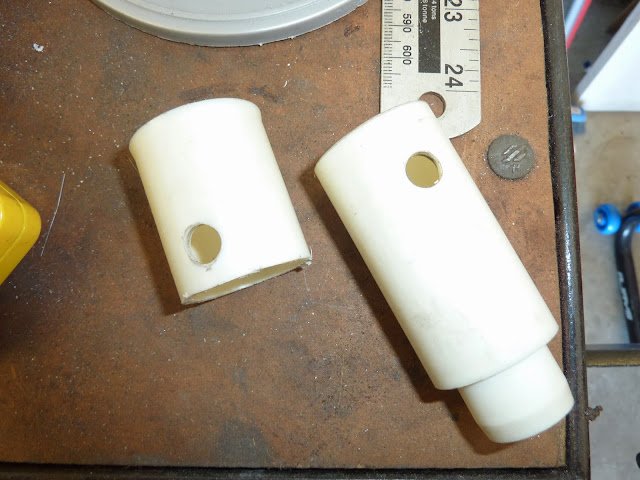One pair of standard length, conventional forks.
Here's why.
The GSX750ES has a clip-on style handlebar with one major issue - it's mounted above the top yoke/triple clamp. If you're going to lose this awful looking tiller, you're left with about 30mm of stanchion stuck above the yoke. This, in itself, looks crap. I've seen lowered cafe racers with that done to them, but it's not really the look I want.
So I need to shorten the forks themselves. Now apparently you can get shortened stanchions from someone in the States, but that'll no doubt prove expensive and probably come with its own set of problems. But by fitting a spacer inside the forks themselves, you can actually reduce the working range of the forks. You'll need to cut the main spring too, but then the fork can be dropped through the clamps, maintaining the bike's original height if need be, and cleaning up the top yoke area.
Here's how.
First, strip the forks. Make a start by slackening the top nut/preload adjuster. I used an airgun to cheat/make it easy. If you're taking them out of the bike first, slacken the top clamps only, and use a tight fitting socket to undo the nut. The lower clamp will prevent the fork from turning.
I then removed the four bolts holding the anti-dive unit on to the bottom of the fork leg. That way I can drain all the oil quickly - strewth, what a state! These forks haven't seen a service in years, maybe never.
This is the back of the ant-dive unit. That'll be stripped, cleaned and checked in another post.
With the dust cover already removed, the circlip is now visible above the washer and oil seal. A right-angled circlip pliers makes this job easy. It's corroded and takes a bit of moving to free up.
The next job is to remove the bottom bolt holding the damper assembly into the bottom of the fork leg. Again I'm cheating. Usually a tool is needed to prevent the damper spinning inside the stanchion while unscrewing the bolt. If you use an airgun, it will normally whip it out before the damper has chance to turn. Happy days.
Next I grab the stanchion and pull it up hard against the seal. It takes a few smacks, but eventually pops up through with the top bush. The seal is now easily removed to reveal the carnage inside. Man, this oil is crappy!
Oil with this amount of metal suspended in it just wears the internals away. Changing it regularly prevents wear, and gives a much better ride.
The damper assembly pulls apart and the rod and top-out spring are removed through the top of the stanchion. Now it's time to degrease every component.
This is the damper rod and top-out spring, and this is what I'm altering. Simply placing a spacer above the spring prevents the fork from extending fully, and fork height is reduced. As luck would have it, a piece removed from the frame is a perfect fit on the tube. I cut a couple of pieces just slightly short of the oil bleed holes (don't want to block those).
Damn, I miss having a lathe sometimes - hacksaw and file it is then.
And that's it!
Reassembly will commence when the sliders have been painted, and I've acquired new stanchions. Watch this space.



















